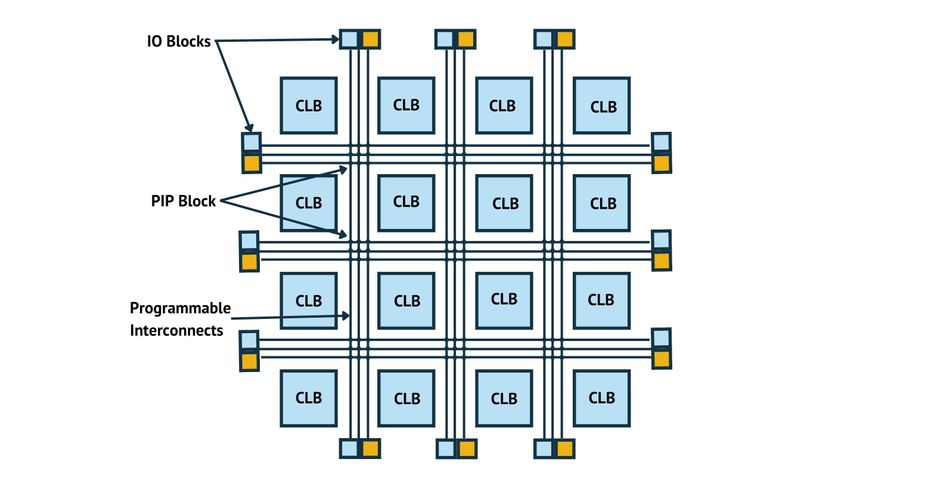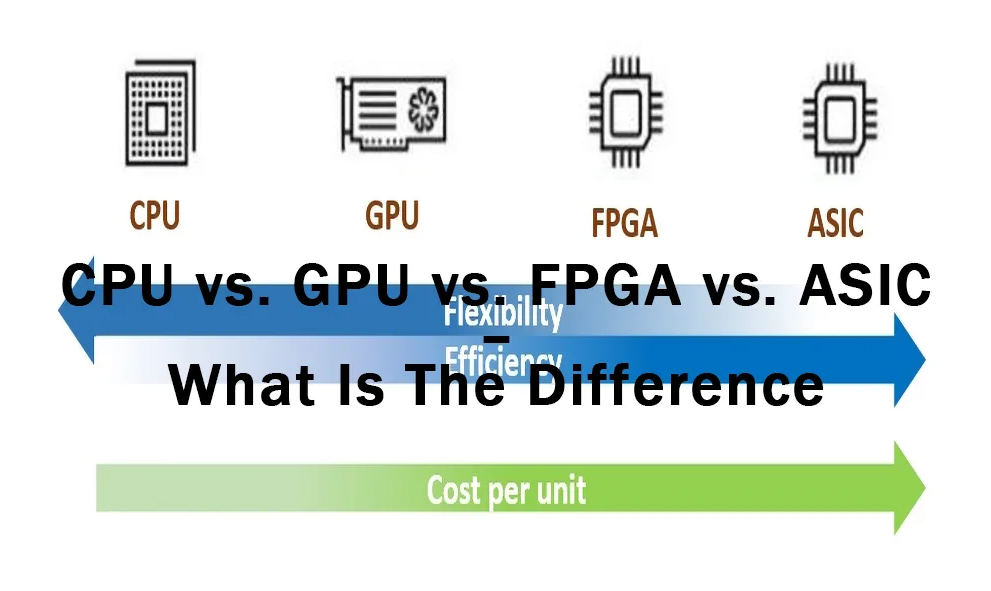FPGAs (Field Programmable Gate Array) are a transformative technology in the electronics world, offering unmatched flexibility and performance for a wide range of applications. Unlike fixed-function chips, an FPGA can be reprogrammed after manufacturing, allowing engineers to design custom hardware solutions tailored to specific needs.
This configurability has made FPGAs essential in industries such as telecommunications, artificial intelligence, automotive electronics, and industrial automation. In this guide, we will explore what FPGAs are, how they work, their advantages and disadvantages, key applications, and how to get started with FPGA development.
What is an FPGA?
The Formal Definition of a Field-Programmable Gate Array
A Field-Programmable Gate Array is a semiconductor device made up of configurable logic blocks (CLBs) connected via programmable interconnects. Unlike fixed-function chips such as CPUs or ASICs, FPGAs can be reprogrammed after manufacturing to perform different digital logic functions. This configurability allows engineers to tailor hardware designs to specific project requirements without fabricating a new chip.
Simply put, an FPGA is like a blank digital canvas where you can “draw” any custom circuit design you need.

FPGA block diagram
How FPGAs Work: A Look Inside (LUTs, CLBs, IOBs, Routing)
An FPGA is built from a collection of modular components that work together to execute custom hardware logic. Understanding these building blocks helps explain why FPGAs are so powerful and flexible.
Key Internal Components:
· Look-Up Tables (LUTs)
· Small memory blocks that store truth tables for implementing basic logic functions (e.g., AND, OR, XOR).
· Can be combined to perform more complex logic.
· Act as the “logic cells” inside the FPGA.
· Configurable Logic Blocks (CLBs)
· Contain multiple LUTs along with flip-flops/registers for sequential logic.
· Serve as the primary computational units of the FPGA.
· Can be configured to handle both combinational and sequential logic tasks.
· Input/Output Blocks (IOBs)
· Interface between the FPGA and external devices or systems.
· Support multiple I/O standards (e.g., LVDS, CMOS).
· Control data flow in and out of the chip.
· Routing Channels
· Programmable interconnects that link LUTs, CLBs, and IOBs together.
· Allow designers to define precise data paths for optimal performance.
· Enable reconfiguration by changing routing connections without altering physical hardware.
 internal architecture diagram showing a LUT (Look-Up Table), D-FF (D Flip-Flop), and MUX (Multiplexer) with inputs A, B, C, D, Rst, Clk and an output.png)
CLB (Configurable Logic Block) internal architecture diagram showing a LUT (Look-Up Table), D-FF (D Flip-Flop), and MUX (Multiplexer) with inputs A, B, C, D, Rst, Clk and an output
Why Choose an FPGA? Key Advantages, Disadvantages, and Applications
The Core Advantages of FPGAs
· Massive Parallel Processing: Multiple tasks can run simultaneously on dedicated hardware paths, significantly improving performance for real-time and data-intensive applications.
· Flexible: Hardware can be reprogrammed after deployment, allowing updates, feature modifications, or bug fixes without replacing the device.
· Low Latency: Direct hardware execution reduces delays between input and output, making FPGAs ideal for high-speed trading, video streaming, and industrial automation.
· Custom Optimization: Hardware resources can be allocated specifically for the target application, delivering better performance compared to general-purpose processors.
· Enhanced Security Options: Custom logic design enables secure, application-specific data processing pipelines that are more resistant to common cyber threats.
The Inherent Disadvantages
· Steep Learning Curve: FPGA development requires knowledge of hardware description languages (HDLs) such as VHDL or Verilog, which can be challenging for beginners.
· Higher Initial Cost: FPGA boards and devices are often more expensive than microcontrollers or general-purpose CPUs for low-volume projects.
· Greater Power Usage: FPGAs typically consume more energy than ASICs or optimized microcontrollers performing the same fixed function.
· Longer Development Time: The design, synthesis, and verification processes take longer than software development, which can slow down time-to-market.
Top Applications Where FPGAs Shine
FPGAs are not limited to niche engineering projects—they are at the core of many high-performances, real-world systems across multiple industries. Their unique combination of parallel processing, re configurability, and low-latency execution makes them a preferred choice for applications where speed, flexibility, and reliability are essential. Below are some of the key sectors where FPGAs deliver significant advantages.
· Telecommunications: Used in 5G base stations, network switching, and optical transport systems for real-time data handling.
· Data Centers: Accelerates database search, encryption, and content delivery while reducing CPU load.
· AI Acceleration: Executes neural network inference quickly, enabling fast decision-making in vision, speech, and NLP tasks.
· Automotive: Powers ADAS, infotainment systems, and real-time sensor fusion for safety-critical operations.
· Industrial Automation: Drives robotics, machine vision, and real-time control systems with high adaptability.
FPGA vs. CPU vs. GPU vs. ASIC
When comparing FPGAs to other computing devices, several differences stand out. CPUs excel at general-purpose tasks and offer easy programming with high-level languages, but they are not as efficient for specialized, parallel workloads. GPUs provide massive parallel processing power for data-heavy applications, but they are less flexible than FPGAs in terms of hardware customization. ASICs deliver unmatched performance and efficiency for a single dedicated task, but once manufactured, they cannot be changed.
|
Feature |
FPGA |
CPU |
GPU |
ASIC |
|
Performance |
High (customized) |
Moderate |
High (parallel workloads) |
Very high (specific task) |
|
Flexibility |
Very high |
High |
Moderate |
None |
|
Development |
Complex (HDL) |
Easy (high-level languages) |
Easy (CUDA/OpenCL) |
Very complex (fabrication) |
|
Cost |
Medium–High |
Low–Medium |
Medium–High |
Very high |
|
Power Usage |
Medium–High |
Low–Medium |
High |
Low |

CPU, GPU, FPGA, and ASIC comparison diagram illustrating the trade-off between flexibility and cost per unit across different processing architectures
How to Choose the Right Device for Your Project
If your project requires real-time performance, custom hardware logic, and the flexibility to reprogram as requirements evolve, an FPGA is the best choice. For simpler, software-based tasks, a CPU is typically more efficient. If you’re working on large-scale data processing or AI model training, a GPU might be ideal. For high-volume production of a fixed-function product, an ASIC will deliver the best performance per watt.
Getting Started with FPGA Development: A Beginner's Roadmap
Getting started with FPGA development involves a clear, sequential process. The following steps outline the typical design flow:
1. Design Entry: This is where you write the code that describes the digital circuit. You'll use a Hardware Description Language (HDL) like VHDL or Verilog to describe the logic, registers, and connections of your design.
2. Synthesis: The synthesis tool takes your HDL code and translates it into a netlist, a low-level description of the logic gates and flip-flops that will make up your circuit. Think of it as compiling your code into a hardware schematic.
3. Simulation: Before programming the actual hardware, you should verify your design's functionality. A functional simulation confirms your logic is correct, while a timing simulation checks for potential delays and ensures the circuit operates at the desired speed.
4. Implementation (Place & Route): In this step, the software maps the logical gates from the netlist onto the physical resources of the specific FPGA chip. It "places" the components and "routes" the connections between them, optimizing for performance and resource utilization.
5. Bitstream Generation: After implementation, the software generates a bitstream file. This is a binary file that contains the configuration data for the FPGA, essentially a blueprint for how the logic gates and connections should be configured on the chip.
6. On-Board Verification: Finally, you load the bitstream onto the FPGA board. Using a JTAG programmer, the bitstream is transferred to the FPGA, reconfiguring its internal structure to create your custom circuit. At this point, you can test the physical hardware and verify its functionality with real-world inputs and outputs.
Mastering the Languages: An Introduction to VHDL and Verilog
The two primary Hardware Description Languages (HDLs) for FPGA development are VHDL and Verilog. These aren't programming languages in the traditional sense; rather, they are used to describe digital circuits.
· VHDL (VHSIC Hardware Description Language) is known for being verbose and strongly typed, making it less prone to certain types of errors. It's often favored in academic and defense industries.
· Verilog is known for its C-like syntax and is often seen as being easier to learn for those with a software background. It's widely used in the commercial sector.
Choosing one is often a matter of personal preference or project requirements, as both are equally capable of describing complex hardware designs.
Essential Development Tools and Software (Xilinx Vivado, Intel Quartus Prime)
The major FPGA vendors provide comprehensive software suites to manage the entire design flow. These tools are often complex but essential for development.
· Xilinx Vivado: This is the primary design suite for AMD's (formerly Xilinx) FPGAs. It supports the entire design flow, from HDL entry and synthesis to implementation and bitstream generation. A free Vivado ML Standard Edition is available for hobbyists and students.
· Intel Quartus Prime: This is the equivalent software suite for Intel's (formerly Altera) FPGAs. It provides a similar set of tools and a user-friendly interface. A free version, Quartus Prime Lite Edition, is available for their lower-cost FPGAs.
These integrated development environments (IDEs) are crucial as they automate most of the complex steps in the FPGA design flow, allowing you to focus on the circuit design itself.
Major FPGA Brands and Recommended Development Boards
The Two Giants: Xilinx (now AMD) vs. Intel (formerly Altera)
The FPGA industry is a duopoly, primarily controlled by AMD and Intel. Xilinx, which was acquired by AMD in 2022, has been the market leader for decades, holding a significant market share (often 50-60%). Their FPGAs, like the Artix and Kintex series, are known for their performance and extensive ecosystem.
In contrast, Altera was acquired by Intel in 2015, giving Intel a strong foothold in the FPGA market. Intel's FPGAs, such as the Cyclone and Arria series, are known for their strong emphasis on integration with Intel's other product lines, particularly in the data center space.
Top FPGA Development Boards for Beginners and Hobbyists
When starting with FPGAs, it's best to choose a board with a good balance of features, a reasonable price, and strong community support. Here are some of the top-recommended boards for beginners:
For those starting out, there are several accessible options:
· Xilinx Spartan-7 Starter Kit: Affordable and ideal for learning FPGA basics, priced around $150.
· Intel DE10-Lite: Compact and beginner-friendly, available for about $130.
· Digilent Nexys A7: Suitable for both learning and prototyping, costing around $250.
· Terasic DE1-SoC: Combines an FPGA with an ARM processor, priced around $300.
FAQ (Frequently Asked Questions)
Can I program an FPGA with C or Python?
Yes, with High-Level Synthesis (HLS) tools such as Xilinx Vitis HLS or OpenCL-based frameworks, you can write FPGA logic in C , Python, or OpenCL. However, for maximum performance and control, VHDL or Verilog is recommended.
What is the total cost of FPGA development (Hardware Software)?
For beginners, development can start at around $150–$400 for a good FPGA board. Many development tools have free versions, though professional licenses for advanced features can be costly. Industrial-scale projects can reach thousands of dollars.
Xilinx vs. Intel FPGAs: How do I choose the right one for me?
If you need cutting-edge performance, a rich ecosystem, and a large support community, Xilinx is often the best choice. For integrated solutions, cost efficiency, and seamless CPU integration, Intel FPGAs are worth considering.
Final Thoughts
FPGAs combine the speed of dedicated hardware with the flexibility of software-programmable systems. Whether you’re developing a low-latency AI accelerator, a high-performance telecom system, or a custom industrial control solution, understanding FPGAs (Field Programmable Gate Array) opens the door to a new level of innovation and performance.





